Finance Assignment - ACC00716: Risk, Return, and Valuation Analysis
VerifiedAdded on 2023/01/19
|7
|1860
|83
Homework Assignment
AI Summary
This finance assignment, ACC00716, analyzes financial concepts through a business case study. It begins with calculations on time value of money and bond valuation. The core of the assignment focuses on risk and return analysis, including the application of the Capital Asset Pricing Model (CAPM) to estimate expected returns for a case company (MYOB) and a hypothetical company. It involves calculating portfolio returns and beta, and comparing risk-return profiles of individual stocks and a formed portfolio. The assignment also delves into the relationship between risk and return, discussing systematic and unsystematic risk, and the benefits of diversification. The student uses S&P Capital IQ data to support their calculations and analysis, and the assignment concludes with a comparison of risk-adjusted returns, demonstrating the superiority of a diversified portfolio in accordance with Modern Portfolio Theory (MPT).

FINANCE
ACC00716
STUDENT ID:
[Pick the date]
ACC00716
STUDENT ID:
[Pick the date]
Paraphrase This Document
Need a fresh take? Get an instant paraphrase of this document with our AI Paraphraser
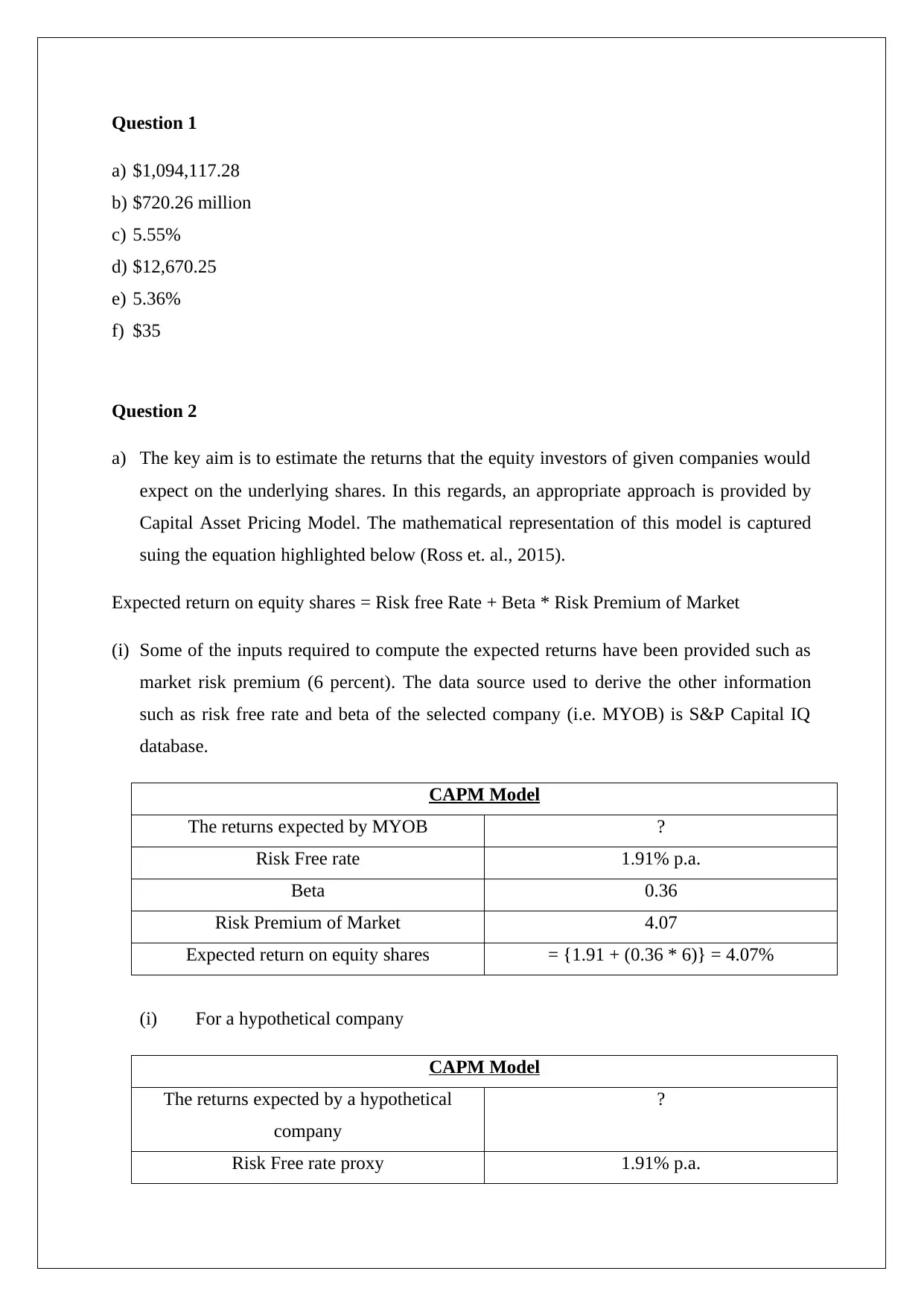
Question 1
a) $1,094,117.28
b) $720.26 million
c) 5.55%
d) $12,670.25
e) 5.36%
f) $35
Question 2
a) The key aim is to estimate the returns that the equity investors of given companies would
expect on the underlying shares. In this regards, an appropriate approach is provided by
Capital Asset Pricing Model. The mathematical representation of this model is captured
suing the equation highlighted below (Ross et. al., 2015).
Expected return on equity shares = Risk free Rate + Beta * Risk Premium of Market
(i) Some of the inputs required to compute the expected returns have been provided such as
market risk premium (6 percent). The data source used to derive the other information
such as risk free rate and beta of the selected company (i.e. MYOB) is S&P Capital IQ
database.
CAPM Model
The returns expected by MYOB ?
Risk Free rate 1.91% p.a.
Beta 0.36
Risk Premium of Market 4.07
Expected return on equity shares = {1.91 + (0.36 * 6)} = 4.07%
(i) For a hypothetical company
CAPM Model
The returns expected by a hypothetical
company
?
Risk Free rate proxy 1.91% p.a.
a) $1,094,117.28
b) $720.26 million
c) 5.55%
d) $12,670.25
e) 5.36%
f) $35
Question 2
a) The key aim is to estimate the returns that the equity investors of given companies would
expect on the underlying shares. In this regards, an appropriate approach is provided by
Capital Asset Pricing Model. The mathematical representation of this model is captured
suing the equation highlighted below (Ross et. al., 2015).
Expected return on equity shares = Risk free Rate + Beta * Risk Premium of Market
(i) Some of the inputs required to compute the expected returns have been provided such as
market risk premium (6 percent). The data source used to derive the other information
such as risk free rate and beta of the selected company (i.e. MYOB) is S&P Capital IQ
database.
CAPM Model
The returns expected by MYOB ?
Risk Free rate 1.91% p.a.
Beta 0.36
Risk Premium of Market 4.07
Expected return on equity shares = {1.91 + (0.36 * 6)} = 4.07%
(i) For a hypothetical company
CAPM Model
The returns expected by a hypothetical
company
?
Risk Free rate proxy 1.91% p.a.
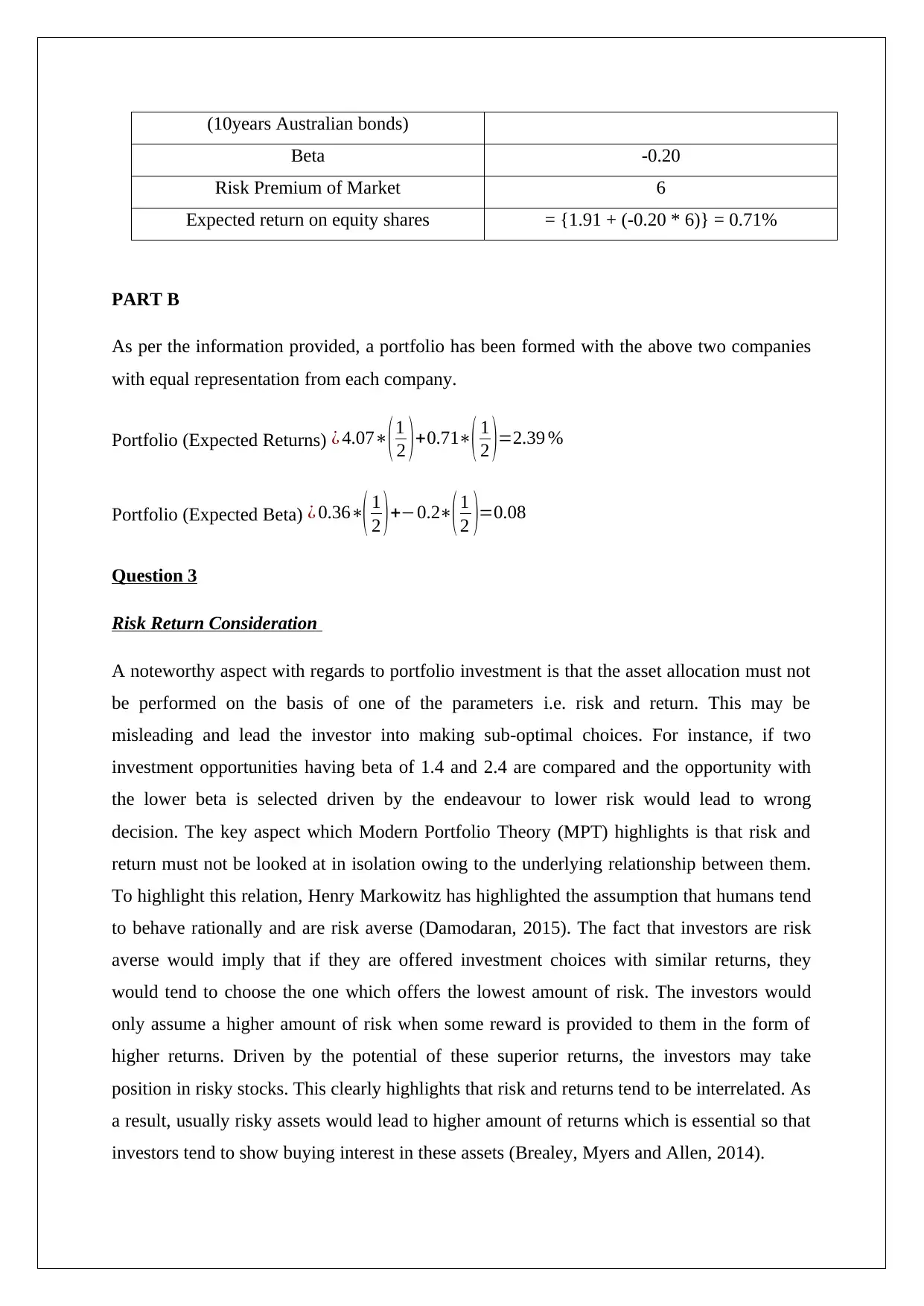
(10years Australian bonds)
Beta -0.20
Risk Premium of Market 6
Expected return on equity shares = {1.91 + (-0.20 * 6)} = 0.71%
PART B
As per the information provided, a portfolio has been formed with the above two companies
with equal representation from each company.
Portfolio (Expected Returns) ¿ 4.07∗(1
2 )+0.71∗( 1
2 )=2.39 %
Portfolio (Expected Beta) ¿ 0.36∗( 1
2 )+−0.2∗(1
2 )=0.08
Question 3
Risk Return Consideration
A noteworthy aspect with regards to portfolio investment is that the asset allocation must not
be performed on the basis of one of the parameters i.e. risk and return. This may be
misleading and lead the investor into making sub-optimal choices. For instance, if two
investment opportunities having beta of 1.4 and 2.4 are compared and the opportunity with
the lower beta is selected driven by the endeavour to lower risk would lead to wrong
decision. The key aspect which Modern Portfolio Theory (MPT) highlights is that risk and
return must not be looked at in isolation owing to the underlying relationship between them.
To highlight this relation, Henry Markowitz has highlighted the assumption that humans tend
to behave rationally and are risk averse (Damodaran, 2015). The fact that investors are risk
averse would imply that if they are offered investment choices with similar returns, they
would tend to choose the one which offers the lowest amount of risk. The investors would
only assume a higher amount of risk when some reward is provided to them in the form of
higher returns. Driven by the potential of these superior returns, the investors may take
position in risky stocks. This clearly highlights that risk and returns tend to be interrelated. As
a result, usually risky assets would lead to higher amount of returns which is essential so that
investors tend to show buying interest in these assets (Brealey, Myers and Allen, 2014).
Beta -0.20
Risk Premium of Market 6
Expected return on equity shares = {1.91 + (-0.20 * 6)} = 0.71%
PART B
As per the information provided, a portfolio has been formed with the above two companies
with equal representation from each company.
Portfolio (Expected Returns) ¿ 4.07∗(1
2 )+0.71∗( 1
2 )=2.39 %
Portfolio (Expected Beta) ¿ 0.36∗( 1
2 )+−0.2∗(1
2 )=0.08
Question 3
Risk Return Consideration
A noteworthy aspect with regards to portfolio investment is that the asset allocation must not
be performed on the basis of one of the parameters i.e. risk and return. This may be
misleading and lead the investor into making sub-optimal choices. For instance, if two
investment opportunities having beta of 1.4 and 2.4 are compared and the opportunity with
the lower beta is selected driven by the endeavour to lower risk would lead to wrong
decision. The key aspect which Modern Portfolio Theory (MPT) highlights is that risk and
return must not be looked at in isolation owing to the underlying relationship between them.
To highlight this relation, Henry Markowitz has highlighted the assumption that humans tend
to behave rationally and are risk averse (Damodaran, 2015). The fact that investors are risk
averse would imply that if they are offered investment choices with similar returns, they
would tend to choose the one which offers the lowest amount of risk. The investors would
only assume a higher amount of risk when some reward is provided to them in the form of
higher returns. Driven by the potential of these superior returns, the investors may take
position in risky stocks. This clearly highlights that risk and returns tend to be interrelated. As
a result, usually risky assets would lead to higher amount of returns which is essential so that
investors tend to show buying interest in these assets (Brealey, Myers and Allen, 2014).
⊘ This is a preview!⊘
Do you want full access?
Subscribe today to unlock all pages.

Trusted by 1+ million students worldwide
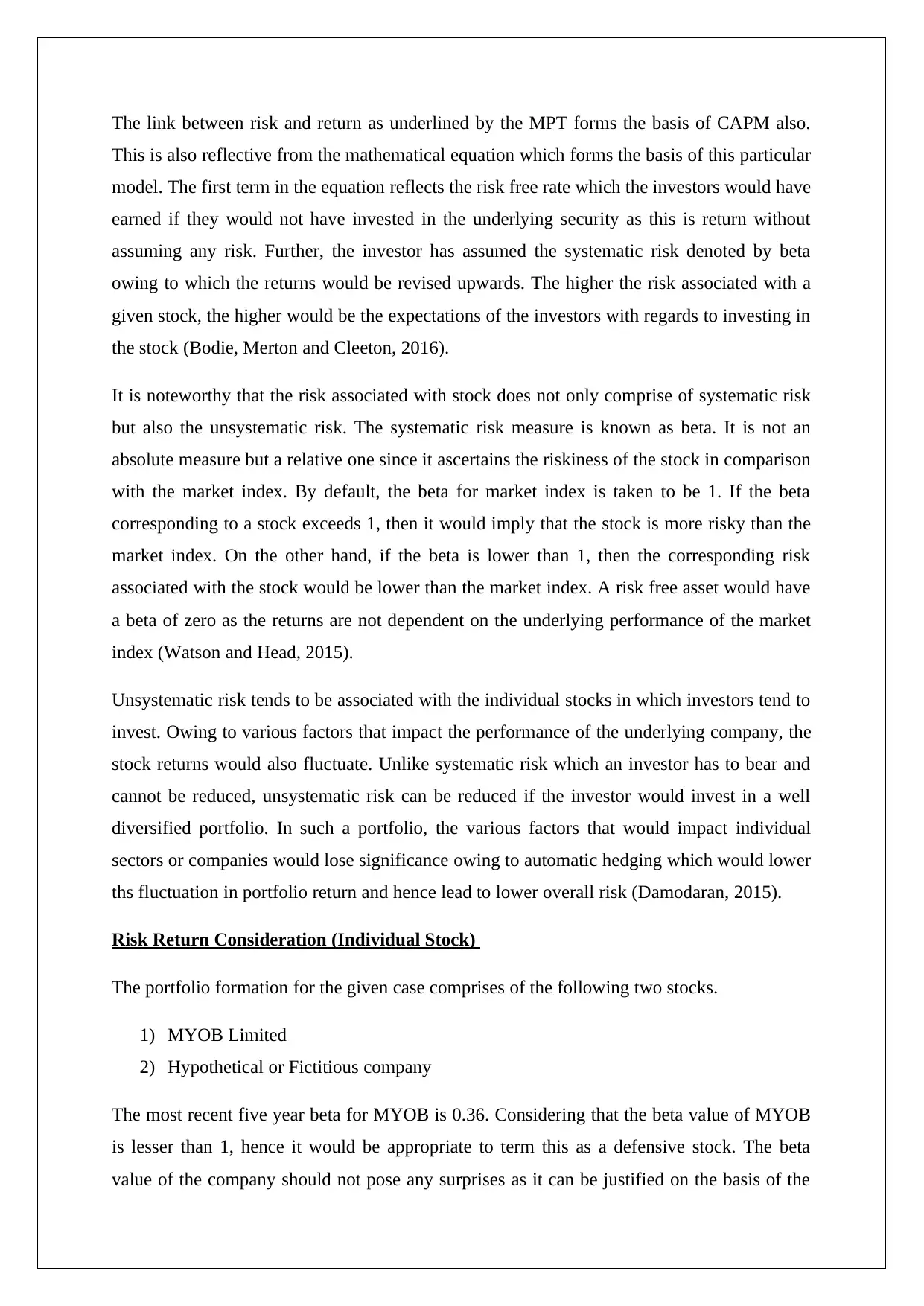
The link between risk and return as underlined by the MPT forms the basis of CAPM also.
This is also reflective from the mathematical equation which forms the basis of this particular
model. The first term in the equation reflects the risk free rate which the investors would have
earned if they would not have invested in the underlying security as this is return without
assuming any risk. Further, the investor has assumed the systematic risk denoted by beta
owing to which the returns would be revised upwards. The higher the risk associated with a
given stock, the higher would be the expectations of the investors with regards to investing in
the stock (Bodie, Merton and Cleeton, 2016).
It is noteworthy that the risk associated with stock does not only comprise of systematic risk
but also the unsystematic risk. The systematic risk measure is known as beta. It is not an
absolute measure but a relative one since it ascertains the riskiness of the stock in comparison
with the market index. By default, the beta for market index is taken to be 1. If the beta
corresponding to a stock exceeds 1, then it would imply that the stock is more risky than the
market index. On the other hand, if the beta is lower than 1, then the corresponding risk
associated with the stock would be lower than the market index. A risk free asset would have
a beta of zero as the returns are not dependent on the underlying performance of the market
index (Watson and Head, 2015).
Unsystematic risk tends to be associated with the individual stocks in which investors tend to
invest. Owing to various factors that impact the performance of the underlying company, the
stock returns would also fluctuate. Unlike systematic risk which an investor has to bear and
cannot be reduced, unsystematic risk can be reduced if the investor would invest in a well
diversified portfolio. In such a portfolio, the various factors that would impact individual
sectors or companies would lose significance owing to automatic hedging which would lower
ths fluctuation in portfolio return and hence lead to lower overall risk (Damodaran, 2015).
Risk Return Consideration (Individual Stock)
The portfolio formation for the given case comprises of the following two stocks.
1) MYOB Limited
2) Hypothetical or Fictitious company
The most recent five year beta for MYOB is 0.36. Considering that the beta value of MYOB
is lesser than 1, hence it would be appropriate to term this as a defensive stock. The beta
value of the company should not pose any surprises as it can be justified on the basis of the
This is also reflective from the mathematical equation which forms the basis of this particular
model. The first term in the equation reflects the risk free rate which the investors would have
earned if they would not have invested in the underlying security as this is return without
assuming any risk. Further, the investor has assumed the systematic risk denoted by beta
owing to which the returns would be revised upwards. The higher the risk associated with a
given stock, the higher would be the expectations of the investors with regards to investing in
the stock (Bodie, Merton and Cleeton, 2016).
It is noteworthy that the risk associated with stock does not only comprise of systematic risk
but also the unsystematic risk. The systematic risk measure is known as beta. It is not an
absolute measure but a relative one since it ascertains the riskiness of the stock in comparison
with the market index. By default, the beta for market index is taken to be 1. If the beta
corresponding to a stock exceeds 1, then it would imply that the stock is more risky than the
market index. On the other hand, if the beta is lower than 1, then the corresponding risk
associated with the stock would be lower than the market index. A risk free asset would have
a beta of zero as the returns are not dependent on the underlying performance of the market
index (Watson and Head, 2015).
Unsystematic risk tends to be associated with the individual stocks in which investors tend to
invest. Owing to various factors that impact the performance of the underlying company, the
stock returns would also fluctuate. Unlike systematic risk which an investor has to bear and
cannot be reduced, unsystematic risk can be reduced if the investor would invest in a well
diversified portfolio. In such a portfolio, the various factors that would impact individual
sectors or companies would lose significance owing to automatic hedging which would lower
ths fluctuation in portfolio return and hence lead to lower overall risk (Damodaran, 2015).
Risk Return Consideration (Individual Stock)
The portfolio formation for the given case comprises of the following two stocks.
1) MYOB Limited
2) Hypothetical or Fictitious company
The most recent five year beta for MYOB is 0.36. Considering that the beta value of MYOB
is lesser than 1, hence it would be appropriate to term this as a defensive stock. The beta
value of the company should not pose any surprises as it can be justified on the basis of the
Paraphrase This Document
Need a fresh take? Get an instant paraphrase of this document with our AI Paraphraser
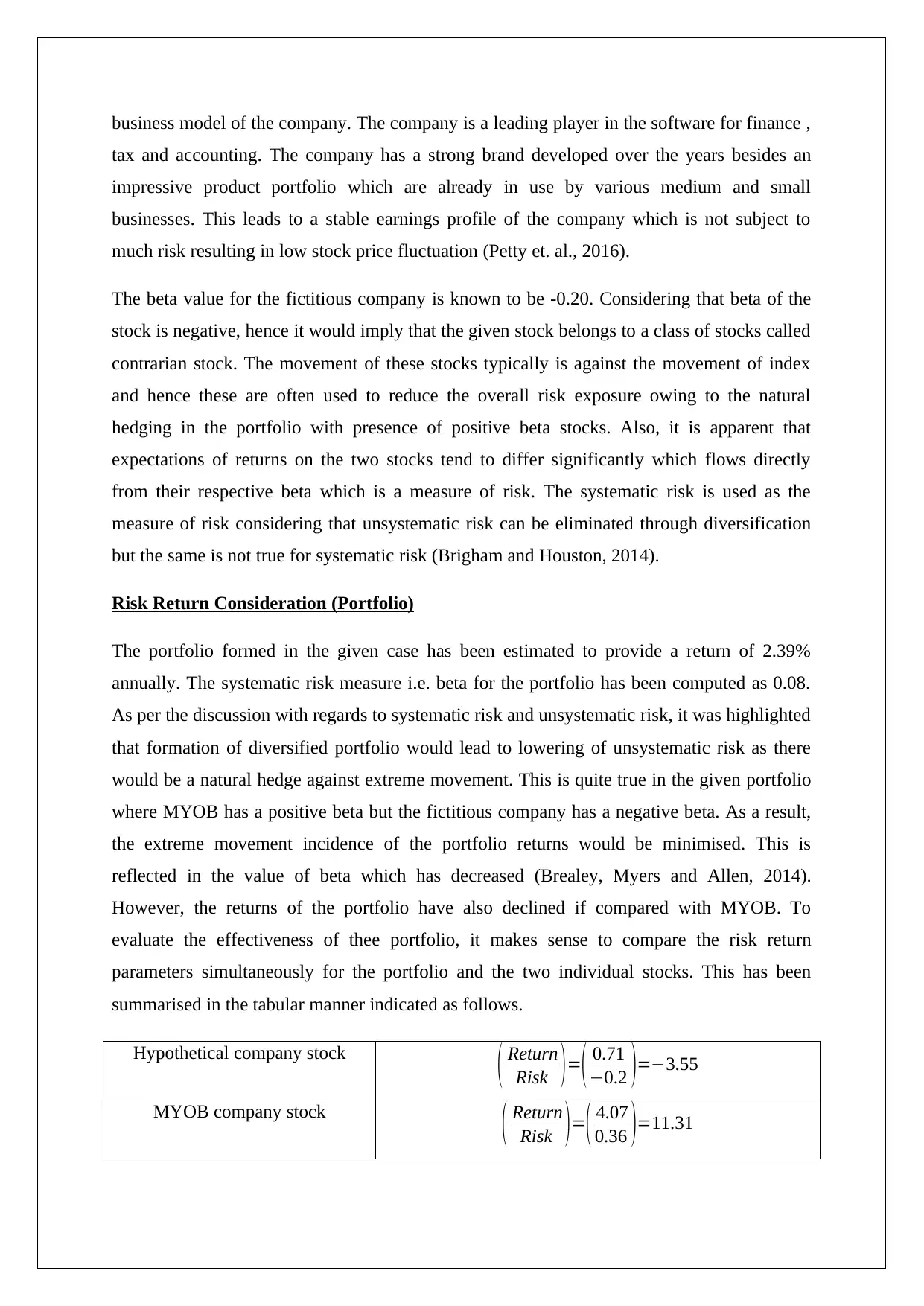
business model of the company. The company is a leading player in the software for finance ,
tax and accounting. The company has a strong brand developed over the years besides an
impressive product portfolio which are already in use by various medium and small
businesses. This leads to a stable earnings profile of the company which is not subject to
much risk resulting in low stock price fluctuation (Petty et. al., 2016).
The beta value for the fictitious company is known to be -0.20. Considering that beta of the
stock is negative, hence it would imply that the given stock belongs to a class of stocks called
contrarian stock. The movement of these stocks typically is against the movement of index
and hence these are often used to reduce the overall risk exposure owing to the natural
hedging in the portfolio with presence of positive beta stocks. Also, it is apparent that
expectations of returns on the two stocks tend to differ significantly which flows directly
from their respective beta which is a measure of risk. The systematic risk is used as the
measure of risk considering that unsystematic risk can be eliminated through diversification
but the same is not true for systematic risk (Brigham and Houston, 2014).
Risk Return Consideration (Portfolio)
The portfolio formed in the given case has been estimated to provide a return of 2.39%
annually. The systematic risk measure i.e. beta for the portfolio has been computed as 0.08.
As per the discussion with regards to systematic risk and unsystematic risk, it was highlighted
that formation of diversified portfolio would lead to lowering of unsystematic risk as there
would be a natural hedge against extreme movement. This is quite true in the given portfolio
where MYOB has a positive beta but the fictitious company has a negative beta. As a result,
the extreme movement incidence of the portfolio returns would be minimised. This is
reflected in the value of beta which has decreased (Brealey, Myers and Allen, 2014).
However, the returns of the portfolio have also declined if compared with MYOB. To
evaluate the effectiveness of thee portfolio, it makes sense to compare the risk return
parameters simultaneously for the portfolio and the two individual stocks. This has been
summarised in the tabular manner indicated as follows.
Hypothetical company stock
( Return
Risk )=( 0.71
−0.2 )=−3.55
MYOB company stock
( Return
Risk )=( 4.07
0.36 )=11.31
tax and accounting. The company has a strong brand developed over the years besides an
impressive product portfolio which are already in use by various medium and small
businesses. This leads to a stable earnings profile of the company which is not subject to
much risk resulting in low stock price fluctuation (Petty et. al., 2016).
The beta value for the fictitious company is known to be -0.20. Considering that beta of the
stock is negative, hence it would imply that the given stock belongs to a class of stocks called
contrarian stock. The movement of these stocks typically is against the movement of index
and hence these are often used to reduce the overall risk exposure owing to the natural
hedging in the portfolio with presence of positive beta stocks. Also, it is apparent that
expectations of returns on the two stocks tend to differ significantly which flows directly
from their respective beta which is a measure of risk. The systematic risk is used as the
measure of risk considering that unsystematic risk can be eliminated through diversification
but the same is not true for systematic risk (Brigham and Houston, 2014).
Risk Return Consideration (Portfolio)
The portfolio formed in the given case has been estimated to provide a return of 2.39%
annually. The systematic risk measure i.e. beta for the portfolio has been computed as 0.08.
As per the discussion with regards to systematic risk and unsystematic risk, it was highlighted
that formation of diversified portfolio would lead to lowering of unsystematic risk as there
would be a natural hedge against extreme movement. This is quite true in the given portfolio
where MYOB has a positive beta but the fictitious company has a negative beta. As a result,
the extreme movement incidence of the portfolio returns would be minimised. This is
reflected in the value of beta which has decreased (Brealey, Myers and Allen, 2014).
However, the returns of the portfolio have also declined if compared with MYOB. To
evaluate the effectiveness of thee portfolio, it makes sense to compare the risk return
parameters simultaneously for the portfolio and the two individual stocks. This has been
summarised in the tabular manner indicated as follows.
Hypothetical company stock
( Return
Risk )=( 0.71
−0.2 )=−3.55
MYOB company stock
( Return
Risk )=( 4.07
0.36 )=11.31

Portfolio formed
( Return
Risk )=( 2.39
0.08 )=29.88
The computations carried in the table highlighted above clearly establish the superiority of
the portfolio over MYOB stock and hypothetical company stock. This is because in
accordance with the MPT the investors do not seek to minimise risk or maximise returns.
Instead, the investor aims to choose the investment which tends to provide the highest risk
adjusted returns where the portfolio is evidently superior owing to diversification (Petty et.
al., 2016).
( Return
Risk )=( 2.39
0.08 )=29.88
The computations carried in the table highlighted above clearly establish the superiority of
the portfolio over MYOB stock and hypothetical company stock. This is because in
accordance with the MPT the investors do not seek to minimise risk or maximise returns.
Instead, the investor aims to choose the investment which tends to provide the highest risk
adjusted returns where the portfolio is evidently superior owing to diversification (Petty et.
al., 2016).
⊘ This is a preview!⊘
Do you want full access?
Subscribe today to unlock all pages.

Trusted by 1+ million students worldwide
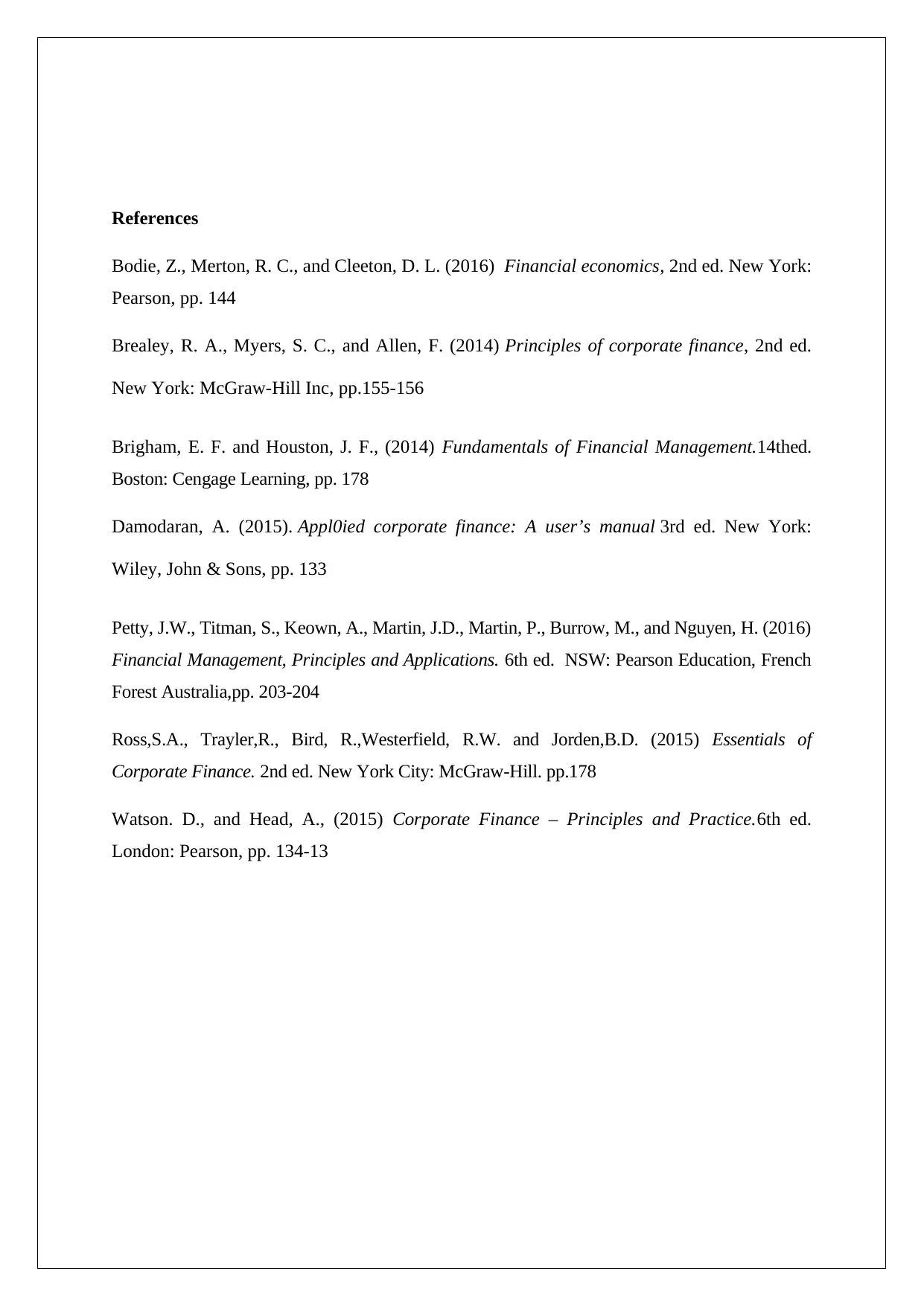
References
Bodie, Z., Merton, R. C., and Cleeton, D. L. (2016) Financial economics, 2nd ed. New York:
Pearson, pp. 144
Brealey, R. A., Myers, S. C., and Allen, F. (2014) Principles of corporate finance, 2nd ed.
New York: McGraw-Hill Inc, pp.155-156
Brigham, E. F. and Houston, J. F., (2014) Fundamentals of Financial Management.14thed.
Boston: Cengage Learning, pp. 178
Damodaran, A. (2015). Appl0ied corporate finance: A user’s manual 3rd ed. New York:
Wiley, John & Sons, pp. 133
Petty, J.W., Titman, S., Keown, A., Martin, J.D., Martin, P., Burrow, M., and Nguyen, H. (2016)
Financial Management, Principles and Applications. 6th ed. NSW: Pearson Education, French
Forest Australia,pp. 203-204
Ross,S.A., Trayler,R., Bird, R.,Westerfield, R.W. and Jorden,B.D. (2015) Essentials of
Corporate Finance. 2nd ed. New York City: McGraw-Hill. pp.178
Watson. D., and Head, A., (2015) Corporate Finance – Principles and Practice.6th ed.
London: Pearson, pp. 134-13
Bodie, Z., Merton, R. C., and Cleeton, D. L. (2016) Financial economics, 2nd ed. New York:
Pearson, pp. 144
Brealey, R. A., Myers, S. C., and Allen, F. (2014) Principles of corporate finance, 2nd ed.
New York: McGraw-Hill Inc, pp.155-156
Brigham, E. F. and Houston, J. F., (2014) Fundamentals of Financial Management.14thed.
Boston: Cengage Learning, pp. 178
Damodaran, A. (2015). Appl0ied corporate finance: A user’s manual 3rd ed. New York:
Wiley, John & Sons, pp. 133
Petty, J.W., Titman, S., Keown, A., Martin, J.D., Martin, P., Burrow, M., and Nguyen, H. (2016)
Financial Management, Principles and Applications. 6th ed. NSW: Pearson Education, French
Forest Australia,pp. 203-204
Ross,S.A., Trayler,R., Bird, R.,Westerfield, R.W. and Jorden,B.D. (2015) Essentials of
Corporate Finance. 2nd ed. New York City: McGraw-Hill. pp.178
Watson. D., and Head, A., (2015) Corporate Finance – Principles and Practice.6th ed.
London: Pearson, pp. 134-13
1 out of 7
Related Documents
Your All-in-One AI-Powered Toolkit for Academic Success.
+13062052269
info@desklib.com
Available 24*7 on WhatsApp / Email
![[object Object]](/_next/static/media/star-bottom.7253800d.svg)
Unlock your academic potential
Copyright © 2020–2026 A2Z Services. All Rights Reserved. Developed and managed by ZUCOL.




